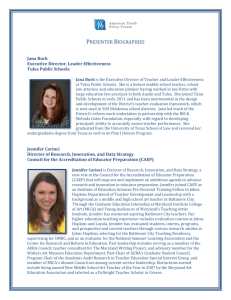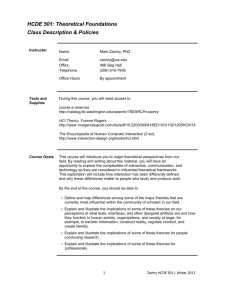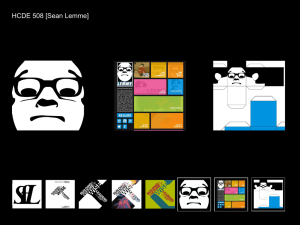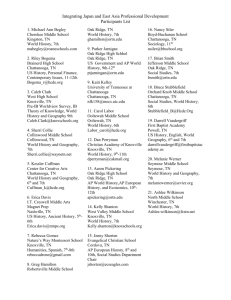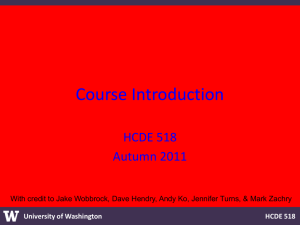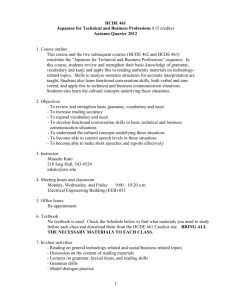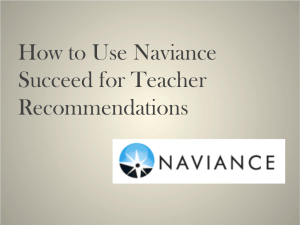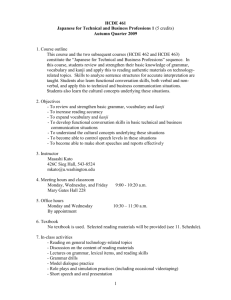Course Introduction, What is Design?
advertisement
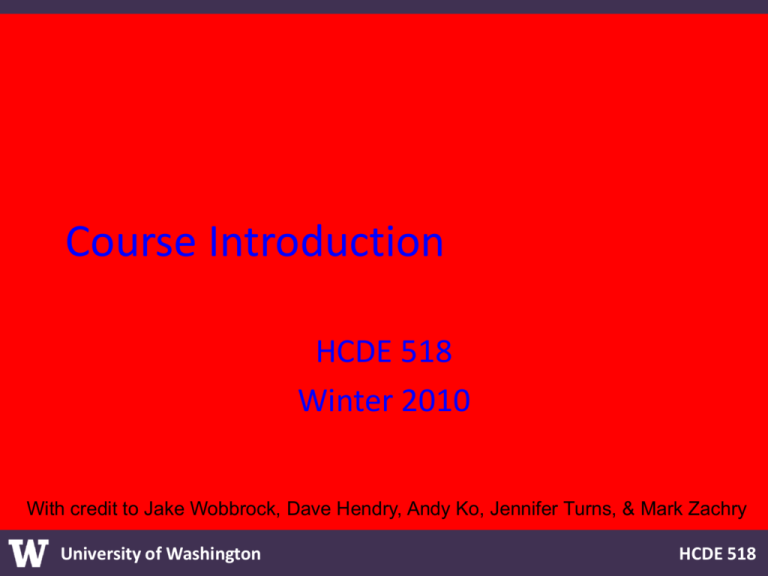
Course Introduction HCDE 518 Winter 2010 With credit to Jake Wobbrock, Dave Hendry, Andy Ko, Jennifer Turns, & Mark Zachry University of Washington HCDE 518 Was that painful? How do you know? Sometimes, painful isn’t so obvious University of Washington HCDE 518 University of Washington HCDE 518 University of Washington HCDE 518 University of Washington HCDE 518 University of Washington HCDE 518 University of Washington HCDE 518 University of Washington HCDE 518 University of Washington HCDE 518 Bad design is everywhere! University of Washington HCDE 518 Bad design can have big consequences Money $60,000 disappeared Social issues Voting University of Washington HCDE 518 Bad design can have big consequences Human Lives Therac-25 Radiation Therapy machine Air traffic accidents !!$rhi Iran Air 655 Airbus shot down by USS Vincennes’ missiles (290 dead); Human error plus confusing and incomplete Aegis interface (S 13 4); Commentary on Tom Wicker article on Vincennes and SDI (S 13 4); Aegis user interface changes recommended; altitude, IFF problems (S 14 1); Analysis implicates Aegis displays and crew (Aerospace America, Apr 1989); Discussion of further intrinsic limitations (Matt Jaffe, S 14 5, R 8 74); USS Sides Cmdr David Carlson questions attack on Iranian jet (S 14 6) University of Washington HCDE 518 But we can try to help Project Ernestine NYNEX was going to buy new workstation for their telephone operators Each second saved per call saves $3M/yr. Gray and John used CPM-GOMS to model use of new workstation Discovered it would be 3% slower than original NYNEX did not buy workstation Prevented mistake, saved $2M/yr. University of Washington HCDE 518 Summary Design is everywhere Design is hard Most everything is designed Much of it poorly Economic ramifications Life and death in certain situations University of Washington HCDE 518 Agenda Motivation – Bad Interface Designs Introductions Instructor, You Break – 5 mins Review of Syllabus Basic Info, Assessment, Assignments, Project, Policies, etc. IDEO Deep Dive Video & Discussion What is Design? Break – 5 mins Perspectives on Design Videos Next Class What this course is about Break – 10 mins University of Washington HCDE 518 Introductions - Instructor Instructor: Julie Kientz (pronounced like “Keentz”) Assistant Professor in HCDE and iSchool Ph.D. in Computer Science from Georgia Tech Research in Human-Computer Interaction Computing for Healthy Living & Learning (CHiLL) Personal Interests: Travel, Skiing, Pets (have 1 dog, 2 cats), Volunteering, Reading, Games, Piano University of Washington HCDE 518 Introductions – You – Design Activity Invent a control for a smart home of the future by: 1. 2. 3. 4. Describing your users Describing your users’ needs Describing the functions Sketching its appearance University of Washington HCDE 518 Design Activity: Process 1. Design Time (10 minutes) a. Work in teams of 2-4 b. Define users, needs, and functions c. Create a sketch 2. Presentation Time (1 minute each) a. b. c. d. e. My Name is … My Name is … This is our control <show sketch> This control is for … <describe users> Use this control to … <describe functions> University of Washington HCDE 518 Design Activity: Reflection Interaction Design – designing interactive products to support the way people communicate and interact in their everyday and working lives in a way that creates an overall positive, engaging, and productive experience University of Washington HCDE 518 BREAK – 5 MINUTES University of Washington HCDE 518 Syllabus Basic Info Assessment Assignments Project Labs Course Topics University of Washington HCDE 518 Basic Course Info Website: http://courses.washington.edu/hcde518/ Mailing List: hcde518a_wi11@u.washington.edu Readings: All posted online, but you can buy several of the books for easier reading: Moggridge University of Washington Buxton HCDE 518 Assessment Component Class Participation Reading Reflections Individual Assignments Sketching Project Group Design Project Final Exam Worth 10% 15% 15% 10% 40% 10% Grades will be posted via Catalyst’s GradeBook and handed back in class University of Washington HCDE 518 Participation – 10% • Treat all with respect – be constructive in all discussions • Come to class prepared – read carefully prior to class meetings • Be an active listener – be attentive, be engaged, use inclass technology with discretion • Ask challenging questions • Comment, build on, or clarify others' contributions • Help your classmates use technologies • Post useful or interesting information to the class discussion list • Visit the instructor during office hours to chat, to ask questions, or to give feedback. University of Washington HCDE 518 Readings – 15% There is a lot of reading in this course As graduate students, I assume that you like to read Readings are all available on course web page None of the readings are pointless Reading Reflections Rn on the schedule 8 total reflections About 1-2 pages per response Pass/fail University of Washington HCDE 518 Assignments – 15% Assignment A1: Thinking About Design A2: Look, Learn, Ask, Try A3: Paper Prototype University of Washington Worth 5% 5% 5% Due 1/11/11 1/25/11 2/22/11 HCDE 518 Project – 40% Group project enabling you to apply the lessons learned in class to a real problem Work in teams of 5 Topics will be determined week 2 Class time will be provided for coordinating team efforts University of Washington HCDE 518 Project Topics List of ideas will be posted on course website Includes: Usability Professionals Association Student Design Competition Past CHI Student Design Competition Topics Future of Technology – Designing for the year 2025 Whatever you’d like! University of Washington HCDE 518 Project Project Component P1: User Research & Personas P2: Ideation & Sketching P3: Prototypes Worth Due Date 15% 2/8/11 5% 2/15/11 10% 3/1/11 P4: Final Report including Evaluation 10% University of Washington 3/8/11 HCDE 518 Team Composition 5 members from a diverse team I get to choose teams…. …but you get some input Fill out team form Turn in at the end of class University of Washington HCDE 518 Sketching Project – 10% • Think about the products and things you use in everyday life • They were all designed by someone! • Designs are rarely perfect the first time • Sketching is an important skill in design • Quantity + Practice increases ability • Sketching is an activity and thought process and way of communicating ideas to others University of Washington HCDE 518 Sketching Project In weeks 2-9, sketch at least 3 new ideas for how you might improve everyday interactive objects relating to that week’s theme Must have at least 24 sketches by the end of the quarter University of Washington HCDE 518 Sketching Project Each class in weeks 2-9 bring your sketchbook to class You will meet in small groups to critique each others’ ideas and take notes At the end of the quarter, you’ll submit your sketchbook and a short report that reflects on your experience University of Washington HCDE 518 Themes Week 2: In the Kitchen – cooking, appliances, eating, food storage, etc. Week 3: Shopping – finding items, purchasing, money, customer service, etc. Week 4: Sports and Recreation –sports equipment, outdoor activities, sporting events, etc. Week 5: Entertainment – movies, video games, television, reading, museums, etc. Week 6: Travel & Transportation – air and car travel, bus travel, bicycling, etc. Week 7: Education – class lectures, assignment turn-ins, elementary school, etc. Week 8: Mobile Interactions – while out and about, driving, walking, etc. Week 9: Family & Friends – keeping in touch, childcare, eldercare, socializing University of Washington HCDE 518 A Note about Drawing Skills Good drawing skills are not required… Stick figures, scribbles, boxes, lines, and annotations are perfectly acceptable! Quality is not important, only idea and quantity. However, you can take a drawing class if you want to get better ASUW Experimental College offers classes: • Drawing for Absolute Beginners University of Washington HCDE 518 Final Exam – 10% Finals week – Tuesday, March 15, 6:00-8:00 P.M. Based on readings Conducted at home, but timed Designed to take approximately 2 hours Should be easy if you keep up with the readings and lecture material University of Washington HCDE 518 Policies Academic integrity Grading Extensions Late assignments Accommodation Quality of written assignments Attendance Food University of Washington HCDE 518 My Expectations of You Be here on time Do the readings before class Turn in everything on-time Speak up in class Turn off cell phones, no texting No email, IM, web Respect each other There are no stupid questions/ideas University of Washington HCDE 518 What You Can Expect of Me I will be here on time Your assignments will be graded in a timely manner Typically within 1-2 weeks I will respond to email in a timely manner Typically within 24 hours If I don’t know the answer to your question, I will find out I will treat you as professional colleagues You will have several chances to evaluate the course University of Washington HCDE 518 Course Topics • User Centered Design Process • User Research Methods • Conveying User Research • Personas & Scenarios • Sketching • Prototyping • Lo-Fi, Hi-Fi, Narrative • Evaluation • Current Trends & Issues University of Washington HCDE 518 What this course isn’t This course isn’t about technology It isn’t (just) about user interfaces It isn’t about “user friendly” It isn’t about programming University of Washington HCDE 518 What this course is This course is about engaging users to design the human-computer system It is about interaction, not interface It is about user success “User friendly” isn’t enough Mantra: “The user is not like me!” University of Washington HCDE 518 What you will learn Design design process design methods creating useful and usable things! Science conduct usability evaluations empirical methods, how to handle data Art an eye for the good, the bad, and the what to do about them University of Washington ugly HCDE 518 BREAK – 10 MINUTES University of Washington HCDE 518 Design Process Intro IDEO’s Deep Dive Video Part 1 - http://www.youtube.com/watch?v=ooN05Q030Qo Part 2 - http://www.youtube.com/watch?v=_7_sZy-kusw Part 3 - http://www.youtube.com/watch?v=FxO8t9Sonk8 University of Washington HCDE 518 Discussion University of Washington HCDE 518 LECTURE – WHAT IS DESIGN? University of Washington HCDE 518 What is Design? Creative endeavor Process of creating or shaping tools or artifacts for direct human use Outputs are things people-centered concerns Processes, methods University of Washington HCDE 518 Characteristics of Design Design… is conscious keeps human concerns in the center is a conversation with materials is creative is communication has social implications is a social activity University of Washington HCDE 518 Design vs. Engineering Engineering Make a mostly-known outcome possible Construct a sturdy bridge based on specifications Concerned with what can be done Reliance on well-established formulae Humans may or may not be directly “in the loop” Design Envision new possibilities, new outcomes Determine what outcome should result among infinite possibilities Reliance on process over formulae Humans are central actors “in the loop” University of Washington HCDE 518 Design vs. Art Design (as we regard it) concerns the creation of something useful and usable Art does not bother with this restriction The test: how to deem what is “good”? University of Washington HCDE 518 Other Contrasts Interface vs. interaction design Artifact versus sequence Graphic < interface < interaction < user experience Usability vs. user experience (UX) design Evaluation versus holistic design Designing it right vs. the right design University of Washington HCDE 518 design vs. Design design: the general activity we’ve been talking about so far Design: the formal field, including theory, methods, literature, and practice University of Washington HCDE 518 Who does design? Designers! Designers are often… Applied anthropologists Design ethnographers Social psychologists Cognitive psychologists Experimental psychologists Computer scientists Engineers Interface designers Interaction designers Industrial designers Graphic designers Information architects Usability professionals Technical writers Dramatists University of Washington HCDE 518 Can anyone be a designer? Don Norman says “yes” Mostly in the “design” sense Bill Buxton says “no” Mostly in the “Design” sense What do you think? University of Washington HCDE 518 University of Washington HCDE 518 University of Washington HCDE 518 What is designed? “Look around you. The only thing not designed is Nature.” David Kelley Anything consciously intended for human use is designed Often poorly, though :( University of Washington HCDE 518 Why is design hard? Interface design is multidisciplinary Judging/predicting which designs will be successful and which will not is difficult It is simply hard to come up with good solutions The space of “the possible” is vast compared to the space of “the good” University of Washington HCDE 518 Why is design hard? All design involves making tradeoffs Can’t maximize everything Good designs are non-obvious Humans are unpredictable Humans make errors Mistakes Slips Design relies on process expertise, not knowledge expertise University of Washington HCDE 518 Core skills of design To synthesize a solution from all of the relevant constraints, understanding everything that will make a difference to the result To frame, or reframe, the problem and objective To create and envision alternatives. To select from those alternatives, knowing intuitively how to choose the best approach. To visualize and prototype the intended solution University of Washington HCDE 518 One view of the design process University of Washington HCDE 518 Sketch of Design Thinking (Andy Ko) University of Washington HCDE 518 Design is not just “lipstick on a pig” Not just changing how things look Or making things pretty Or designing graphics University of Washington HCDE 518 Interaction design mantras “The user is not like me.” –Don Norman “The best way to have good ideas is to have lots of ideas.” – Linus Pauling “Fail often to succeed sooner.” – IDEO “Enlightened trial-and-error succeeds over the careful planning of the lone genius.” – IDEO University of Washington HCDE 518 “The user is not like me” Why not? (from Norman) Designers are much more familiar with the interface and with the problems being solved than users. Designers are confident. Users are often fearful. Designers work in settings that are different than the context in which the product may be used. Designers may have different skills than users (e.g., perceptual, cognitive, or domain skills). University of Washington HCDE 518 Repeat it out loud “The user is not like me” University of Washington HCDE 518 BREAK – 5 MINUTES University of Washington HCDE 518 A1: Thinking about Design Think about the objects with which you interact and how they’re designed Derive design principles Assignment description posted online (A1) Due next Tuesday, 1/11/11 University of Washington HCDE 518 Next Class Topics Tuesday, January 11th The User-Centered Design Process Upcoming Work Get started on readings and reflections Complete Assignment 1 Obtain a sketchbook Sketch 3 sketches relating to “In the Kitchen” University of Washington HCDE 518 VIDEOS – WHAT IS DESIGN? University of Washington HCDE 518 Interviews from Moggridge (2007) Gillian Crampton Smith (Director, Ivrea) 4 minutes Bill Verplank (Xerox Star) 3 minutes Cordell Ratzlaff (Mac OS X) 3 minutes University of Washington HCDE 518 Lessons? What lessons do these interviews hold? University of Washington HCDE 518 Next Class Topics Tuesday, January 11th The User-Centered Design Process Upcoming Work Get started on readings and reflections Complete Assignment 1 Obtain a sketchbook Sketch 3 sketches relating to “In the Kitchen” University of Washington HCDE 518
